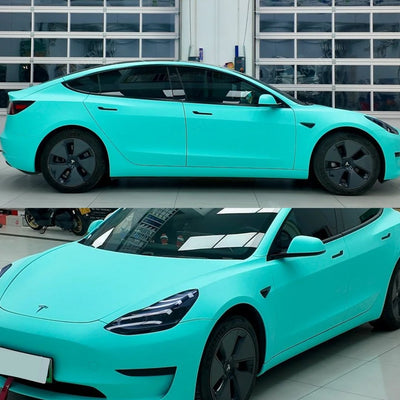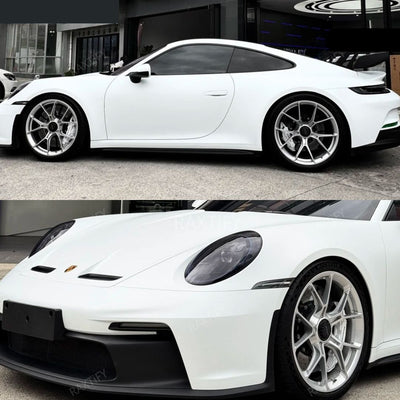Introduction
When it comes to customizing and protecting your vehicle, you have a variety of options to choose from. At our shop, we specialize in Paint Protection Film Wraps and Vinyl Wraps. We often receive questions about which option is best and how they differ. In this blog post, we'll address one common question: which is better, PPF or Vinyl Wrap? Our goal is to assist you in selecting the film that suits your needs best.
To start, let's define what PPF and Vinyl Wraps are.
What is PPF
PPF, short for Paint Protection Film (also known as clearbra), is a nearly invisible, typically 8 mil thick self-healing urethane film applied to your vehicle's surface. It provides exceptional impact protection, shielding your car's paint from scuffs, scratches, and rock chips. Besides impact protection, it safeguards your car's paint from environmental hazards like oil spills, bird droppings, and watermarks. Moreover, it shields your car from the harmful effects of UV light, preventing paint fading.
What is Vinyl Wrap:
Vinyl wrap is a versatile material made from PVC, known for its thinness and flexibility. Typically measuring 3-4 mil thick, vinyl wrap comes in a wide range of colors, finishes, and textures. With its specially formulated adhesive backing, vinyl wrap adheres securely to surfaces, conforming to their shapes.
Primarily used for car customization, vinyl wrap offers endless possibilities for altering the appearance of your vehicle. Whether you're looking to change the color or add a unique finish, vinyl wrap can help you achieve your desired look. Additionally, it's common to use vinyl wrap for accent pieces, selectively wrapping specific parts of the car.
One popular application is the chromedelte, where all chrome surfaces of the vehicle are wrapped in vinyl, typically in black. However, the options for customization are not limited, giving you the freedom to personalize your car according to your preferences.
PPF vs Vinyl Wrap
When considering PPF or Vinyl Wrap for your vehicle, it's essential to understand their distinct purposes and functionalities.
Purpose:
- PPF primarily safeguards the vehicle's paint, maintaining its original appearance and offering significant protection against impacts.
- Conversely, vinyl wraps are geared towards aesthetic transformation, offering numerous customization options from color changes to unique designs.
Surface Protection:
- PPF remains the top choice for extensive exterior protection, especially for off-road or highway driving. Its thicker composition provides a robust barrier against various elements, including rock chips, bird droppings, and UV light.
- While not as thick as PPF, Vinyl Wrap still provides a degree of protection by covering the car's paint and creating a barrier against minor damages. However, it may not safeguard against deep scratches or scuffs as effectively as PPF.
Packages:
- PPF and Vinyl Wrap packages differ in coverage areas. PPF packages often focus on specific areas, with the Full Front package being popular, covering the front of the vehicle (bumper, hood, fenders, mirrors).
- Conversely, Vinyl Wrap is typically applied to the entire vehicle, unless customized designs are requested.
Price:
- PPF jobs generally command a higher price due to material costs and installation complexity. A full PPF wrap for a sedan may cost around $5000 or more.
- In contrast, a full vinyl wrap for a similar-sized vehicle typically costs around $3400, making it a more budget-friendly option.
Installation:
- PPF employs wet installation, requiring the film to be wet for proper adhesion. Installers use a mixture of soap and water or a specialized installation gel. PPF is typically cut using specialized cutting software with patterns that fit each vehicle part precisely
- Vinyl Wraps, on the other hand, are installed dry as any moisture during installation can compromise the adhesion. The film does not adhere well to wet surfaces. Vinyl Wraps are cut by hand, with installers trimming the excess material after installation.
Paint Condition:
- Prior to installation, it's crucial to ensure the paint is in good condition. PPF, being transparent, reveals any paint imperfections. It's advisable to perform paint correction before applying PPF, ideally when the car is new, to protect the pristine paint from damage.
- Vinyl Wraps are more forgiving as they conceal visual imperfections, but they won't hide rock chips or missing paint. Textured imperfections may also be noticeable through the vinyl.
Longevity:
- Properly installed PPF can last up to 10 years with proper care, while Vinyl Wraps typically last around 5 years under similar conditions.
- Both films, if sourced from reputable manufacturers, won't damage the original paint if it's in good condition. However, applying PPF to already damaged paint won't conceal existing flaws, though it will protect against future damage.
Things To Keep In Mind
When deciding on the right wrap for your vehicle, there are key factors to consider. With Paint Protection Film (PPF), although it's transparent, over time, the edges of the wrap may become more visible. Since PPF isn't typically wrapped around edges, dirt can accumulate along cut lines, particularly noticeable on partial wraps like hoods.
As for Vinyl Wraps, remember that the original paint color might show between panels. While black cars are easier to wrap without noticeable differences, transitioning from white to black may reveal some white in the gaps. This occurs because certain areas between panels are unreachable for wrapping. Despite this, we strive to cover as much original color as possible, aiming for a seamless finish that resembles paint.
Conclusion
In conclusion, when deciding between PPF and Vinyl Wrap, it's important to consider their respective purposes. Both options have their merits, catering to slightly different needs.
If you're aiming to alter your vehicle's appearance and provide some level of protection while driving in urban areas, Vinyl Wrap is the ideal choice. It not only offers a customizable look but also helps save money.
On the other hand, if you require comprehensive protection against various hazards on the road and have the budget for it, PPF is the better option. Applying PPF right after purchasing your vehicle from the dealership ensures that its paint remains in pristine condition for years to come.
Ultimately, the choice between PPF and Vinyl Wrap depends on your specific requirements and preferences. Whether you prioritize aesthetics or protection, both options offer valuable solutions for enhancing and safeguarding your vehicle.
































